Speech Some Effects of the Global Financial Crisis on Australian Financial Markets
My talk today focuses on some of the ways that the global financial crisis has affected Australian financial markets. Upfront, the positive point to emphasise is that the effect of the crisis on Australian financial markets has been considerably less than in many other countries. That said, many markets in Australia have been, and continue to be, significantly affected. In some instances, this has warranted a policy response to address the particular market dysfunction.
Before describing some of these effects and the policy responses, I will first give a potted summary of the global financial crisis to give some context to the developments in Australian markets. The Financial Stability Review (FSR) published last Thursday by the Reserve Bank provides a considerably more detailed discussion of the evolution of the crisis, as does the IMF's Global Financial Stability Review.
As the RBA's recent FSR points out, the crisis can be viewed through the prism of risk. Risk premia were excessively low for a number of years leading up to the middle of 2007. There are many explanations that have been advanced for why this was so. Some attribute it to the prolonged period of economic stability in a number of major countries dating back to the early 1990s which caused investors to become overly optimistic about the future. Some attribute it to the low interest rates that prevailed for much of the earlier part of this decade which caused investors to search for higher yields in new and less well understood products. I find the ‘search for yield’ explanation somewhat incomplete. It focuses primarily on the average return of the investment along with the investment's diversification benefit as measured by its correlation with other asset classes. The element that is incomplete is why the risk element of the risk/return trade-off was downplayed or mis-assessed.
Thus I would attribute a very large role in the financial crisis to a wholesale failure of risk assessment and risk management. In that regard, a recent speech by a colleague at the Bank of England, Andy Haldane, highlighted the statement by David Viniar, the CFO of Goldman Sachs, in August 2007:
‘We are seeing things that were 25 standard deviation moves, several days in a row.’
I repeat, that was in August 2007, in the very early days of the crisis. I would hazard a guess that we have seen quite a few more 25 standard deviation moves in the subsequent 18 months. The month of October 2008 following the collapse of Lehman Brothers delivered significantly more than 25 standard deviation events. It was, hopefully, a once in a lifetime event. (As Andy points out in his speech, a 25 standard deviation event actually is already a once in a lifetime event, where the life in this case is that of the universe!)
What this shows is that the models used to assess and manage risk were in many cases plain wrong. This applies to models used by investors, issuers and regulators. In some cases, the models may have been close to right, but their results were overridden by other considerations, including, inter alia, a short-term profit motive and asymmetric compensation for risk-taking.
This mis-assessment or mismanagement of risks led to a large number of investment decisions being taken which have subsequently proved to be extremely costly.
Another mis-assessment that occurred was the assumption that off-balance sheet vehicles, which were investing in these misvalued products, were really off the balance sheets. The disintermediation that had occurred to the ‘shadow’ banking system had turned out to be a veil, not unlike the curtain behind which the Wizard of Oz operated.[2] Once the veil was removed, financial institutions found themselves dealing with large amounts of exposure to underperforming assets that they had not anticipated.
As these exposures have materialised, we have seen an enormous increase in risk aversion. Just as risk premia had been too low for a number of years prior to 2007, we now see an overshooting in the other direction. In addition, trust in the financial system has been substantially compromised, both between the public and the financial sector and between financial institutions. Counterparty risk aversion, that is the willingness to deal with other financial entities, is at elevated levels, with the Lehman's collapse exacerbating an already fragile environment.
While elements of the above problems were present in Australia, they were present to a significantly lesser extent than in many other developed countries. One significant factor contributing to their absence was that the core of the Australian financial sector has remained highly profitable from lending to households and businesses with, for example, the larger Australian banks able to deliver pre-tax rates of returns on equity of well over 20 per cent for many years. Hence there was no need for these institutions to engage in any search for yield outside their traditional realm.
As Australian financial institutions had minimal exposure to the securities that have beset other financial institutions and had solid balance sheets (as documented in the FSR), there has been considerably less concern about counterparty risk in local markets.
Nevertheless, the dislocation in global financial markets over the past two years has translated in varying degrees to local markets. In the remainder of my talk, I will discuss some of these channels.
The most obvious manifestation to the general public of the impact of the financial crisis on Australia has been the decline in the local stock market. From its peak in November 2007 to the lows reached earlier this month, the local market declined by 54 per cent. This fall compares to the peak to trough decline of 57 per cent in the US market, 61 per cent in Europe and 60 per cent in the Japanese market. Thus, the impact on this market has been similar to that in other countries. As Graph 1 shows, the decline in the local market has been one of the largest on record.

While these large falls have been comparable, the Australian market had generally outperformed these other markets in earlier years so that while the US and European stock markets had fallen back to levels last seen in the mid 1990s at the time of their most recent lows, the Australian market had returned to its level of mid 2003. The Japanese market's recent lows were back at levels last seen in 1984.
In recent weeks, the Australian share market has risen along with other global share markets so that for the March quarter to date, the local market is now down by only a few per cent, significantly smaller than the 19 per cent fall recorded in the December quarter.
Reflecting the comparative health of the Australian banking system, the decline in the share prices of commercial banks in Australia has been considerably less than the declines recorded in the US and the UK (Graph 2). The fall has been similar to that for Canada, whose banking system shares a lot of similarities with the Australian one, including its current state of profitability.
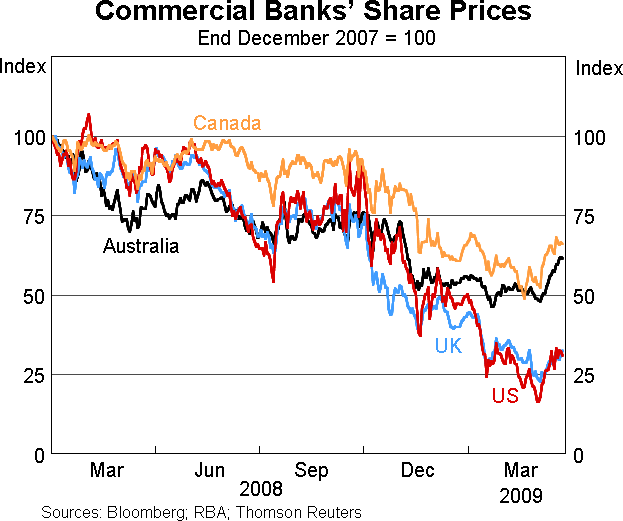
The Australian market along with other equity markets has experienced substantial volatility at times. As Graph 3 shows, in 2008 the number of days where the local market recorded either rises or falls exceeding 3 per cent was unprecedented. Twenty-two of the 40 large movements in 2008 occurred in the fourth quarter. It is interesting to note that despite the market falling substantially in net terms, most of the largest daily movements were actually rises.
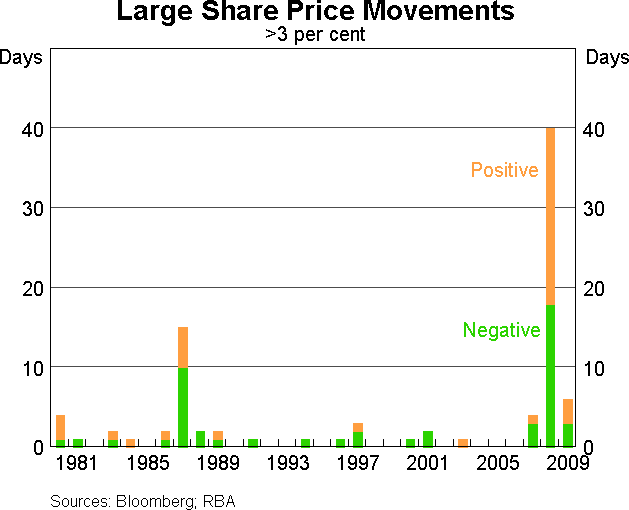
The financial crisis initially developed in the credit market. Indeed, it took a number of months in the second half of 2007 for the equity market to catch up to the credit market. One of the obvious initial manifestations of the crisis was increased spreads in short-term money markets beginning in August 2007. The spread is the difference between bank borrowing costs at a particular maturity and the policy rate expected by the market at the same horizon. These increased spreads were in part a function of the increase in counterparty risk aversion that I spoke about earlier. Banks were more inclined to hold onto cash rather than lend it to others.
The Reserve Bank responded to the resultant increase in precautionary demand for cash by financial institutions by increasing the supply of cash in the system, measured by exchange settlement (ES) balances. If we had not done so, there would have been upward pressure on the cash rate (the interest rate on overnight borrowing in the interbank market) driving it above the target set by the Reserve Bank Board in their monetary policy decision. As the demand for cash has fluctuated throughout the crisis period, the Reserve Bank has adjusted the ES balances to ensure that the cash rate has remained at its targeted level. As Graph 4 shows, the level of ES balances has tended to peak around quarter end, when banks have a preference to have more cash and undertake less interbank lending on their books for reporting purposes.
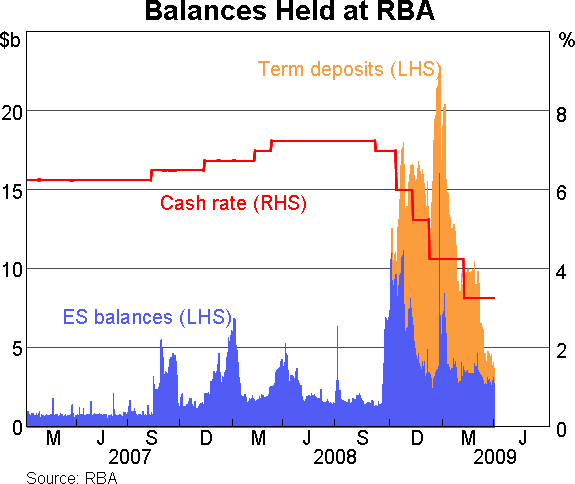
The initial rise in spreads in Australia was significantly less than in the US, UK and Europe where counterparty risk rose considerably further. Indeed, almost throughout the crisis period, money market spreads in Australia have been lower than in other markets.
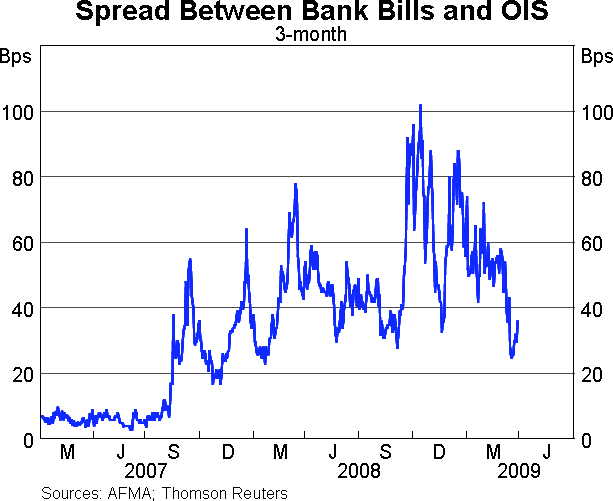
Tensions clearly peaked around the time of the Lehman's collapse, when the spread between the 90-day bank bill and the expected cash rate rose as high as 100 basis points (Graph 5). Turnover in the money market, as was the case in all global markets, was significantly curtailed.
In order to address the pressure on term money market spreads, the Bank increased the maturities of its daily open market operations. This was aimed at enhancing liquidity in the term money market. The Bank's system of open market operations has always had the capacity to adjust the term of the operations very quickly, and we have availed ourselves of this flexibility through the crisis period. Towards the end of last year we began to offer terms of six months and one year on a regular basis.
These issues are discussed in more detail in a speech I gave last October. As I noted in that speech, to allow the Bank greater capacity to address the pressure on term money markets, we introduced a term deposit facility, which is effectively an exchange settlement balance at a longer maturity.
Recently, there have been a number of signs of an improvement in conditions in the money market. Spreads have fallen noticeably, and are now well below the average of the crisis period. They have not fallen back to their pre-crisis levels (although the one-month spread has been around that level in recent days). However, I am not sure the pre-crisis level is necessarily an appropriate benchmark, as it could be argued that spreads were excessively compressed in that period.
Furthermore, as the demand for cash has abated, the Bank has been able to reduce the supply of ES balances back to around $2½ to $3 billion. We have seen demand for longer maturities in our market operations decline significantly. On a number of days when we have offered the longer terms in our daily operations, we have found no demand. Notwithstanding this, the Bank will continue to offer these longer terms on a regular basis going forward. As a result, we have also been able to reduce term deposits outstanding to a very low level with the intention, at this stage, of not offering them again for some time unless circumstances warrant otherwise.
Moving out along the maturity spectrum beyond the short-term money market, there has been a significant impact of the global financial crisis on the bond market. As the crisis has unfolded, there has been a marked process of re-intermediation. Corporates who had previously been able to borrow directly in financial markets found that these markets were no longer accessible and turned to the banks for funding. This process saw a surge in intermediated business credit in Australia in late 2007.
There was very little Australian corporate bond issuance throughout 2008 but in the last few weeks there have been some signs of life. In global bond markets, there has been a marked surge in non-financial corporate issuance since the beginning of this year. Indeed, corporate issuance in the US so far this year has been around or even higher than pre-crisis levels in terms of volume, if not in terms of spread. One interesting development in the local market is that two of the recent corporate offerings have been targeted at the retail market. It will be certainly interesting to see how that plays out.
In Australia, a very large share of private-sector bonds is issued by the financial sector. Again reflecting the developments in global credit markets from August 2007, bond issuance by the banks was clearly affected. Initially, this took the form of a widening in spreads at issuance (Graph 6). Then at various times in the months following, it was difficult to issue at any price (for both Australian and other global financial institutions). The banks therefore took their opportunities to fund themselves as they arose. The banks adopted a conservative strategy of getting as far ahead on their funding programs as possible. This was evident in January and February 2008, when there was sizeable issuance by the banks in offshore markets. Indeed, in January 2008, issuance by Australian banks was a significant share of total issuance (by both US and other global institutions) in the US market.
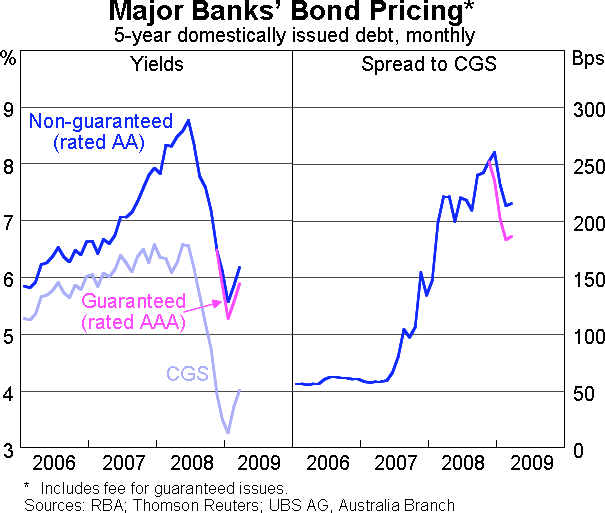
As is evident in Graph 7, funding markets shut completely following the collapse of Lehman Brothers. All global financial markets were dislocated by this event, but not surprisingly term debt markets were about the most affected. The destruction of confidence between counterparties in the financial system was very large. Investors were extremely unwilling to take on any exposure to a financial institution at any maturity. In many money markets around the world, maturities shortened dramatically so that only the overnight market was (barely) functioning and a number of central banks became effectively the intermediator of last resort.
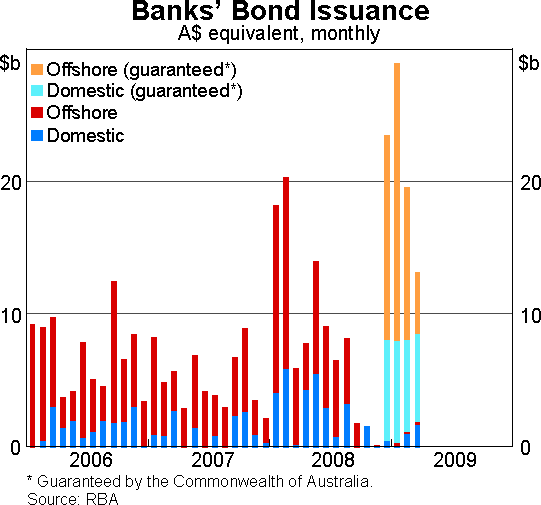
In response to the drying up of term funding markets, a number of countries, beginning with Ireland, began announcing government guarantees to support debt issuance by their banks. In a global financial market, where institutions are competing for funds, the provision of a guarantee to one group meant that it was very difficult for others to compete effectively for funds. Hence, in the wake of the dislocation induced by Lehman's, many countries, including Australia, moved to guarantee bank debt issuance.
Soon after the introduction of the guarantee, Australian banks were able to once again access term debt markets. To date, the Australian banks have raised $81 billion under the guarantee scheme. There has, however, been little investor appetite for unguaranteed debt, despite other indications of an improvement in credit market conditions. It is a little surprising that investors do not have interest in unguaranteed paper, and are not keen to see part of the 70 basis point fee that the banks pay to the Government for the guarantee ending up in their own pocket instead.
As a result of their ability to issue under the guarantee scheme, the Australian banks are well advanced on their funding needs for this year. Their funding needs have been further addressed by the rapid growth in deposits in recent months. The combination of increased term funding and deposit growth has seen a decline in the share of bank funding accessed from short-term wholesale debt markets.
While term funding markets are functioning better, and there have been some recent signs of life in the corporate bond market, the same cannot be said of the securitised debt market. As is well known to all, securitisation has been at the heart of the global financial crisis since its inception. While the problems in the securitisation process in the US, many of which relate to the mis-assessment and mismanagement of risk discussed earlier, were not present in the Australian market, the local market has been similarly dislocated.
Prior to the crisis, securitisation accounted for around 25 per cent of housing credit in Australia. However, as I described in an earlier speech, and my colleague Tony Richards discussed last week, the process of securitisation in Australia was significantly different to that in the US. In Australia, the institution originating the loans that comprised the securitisation maintained a number of linkages to the loans, typically including a direct financial stake, as well as a substantial reputational link. Moreover, lending standards in Australia did not change materially. The data indicate that the loans that were securitised by banks were not materially different in quality from those that were not. For the banking sector, securitisation was primarily an alternative funding source that was accessed when it was cost effective to do so and provided a more diversified funding base. Obviously for the non-banking sector, securitisation was the primary funding source. As the securitised market has been dislocated, the non-banking sector has been particularly affected.
Graph 8 shows that issuance of residential mortgage-backed securities (RMBS) since the second half of 2007 has been minimal. One factor contributing to this development has been the sizeable overhang of supply in the secondary market. Prior to the crisis, well over half of Australian RMBS were bought by offshore investors, of which structured investment vehicles (SIVs) were an important component. The demise of the SIVs has seen both a marked reduction in demand but also has seen them sell the RMBS back into the local market as they were forced to liquidate their portfolios. As a result, spreads in the secondary market are very wide, and far too wide to make new issuance economic.
To address this problem, the Government, through the Australian Office of Financial Management (AOFM), has undertaken a program of purchasing new RMBS issues. To date, the AOFM has purchased $3 billion of RMBS, with a further $5 billion to be purchased. However, there has been no issuance in recent months other than the AOFM program.

At the shorter end of the asset-backed market, the asset-backed commercial paper (ABCP) market has also been substantially affected. ABCP outstanding in the onshore market rose in the first few months as a number of banks funded back onshore, assets which had previously been funded offshore as the offshore market was greatly impaired (Graph 9). Subsequently, as investor appetite for ABCP has diminished domestically too, the stock of paper outstanding has declined significantly, the cost of issuing the paper has risen and the average maturity has shortened.
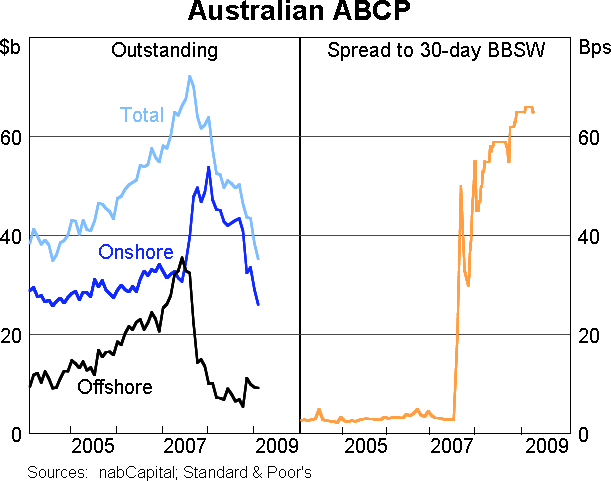
In response to the dislocation in these asset-backed markets, the Reserve Bank has widened the pool of collateral that is eligible in our open market operations. Most forms of highly rated asset-backed paper are now eligible.
Taken together, the increased money market spreads, the increased spreads on longer term issuance and the dislocation in securitised markets have seen a rise in the cost to the banks of funding their lending. For a few years prior to the crisis, much of the banks' funding tended to move broadly in line with the cash rate set by the Reserve Bank Board. However, with the rise in spreads that has occurred, this relationship is currently not as strong. This has then contributed to the divergence between movements in the cash rate and lending rates.
Notwithstanding this, as was noted in the most recent Statement on Monetary Policy, the pass-through of the reduction in the cash rate since last September to housing interest rates has been more complete than in almost any other developed country. This means that this important channel of the monetary transmission process has not been impaired, in stark contrast to a number of other countries, most notably the US. The relative strength of Australian financial institutions and Australian financial markets more generally has ensured that this has occurred.
I will now turn to discuss some of the effects of the crisis on the foreign exchange market. I covered this topic in detail only recently, so I will be brief here. The most obvious impact of the crisis has been the depreciation of the Australian dollar, but in addition to that, a notable development has been the marked increase in volatility in the foreign exchange market. As Graph 10 shows, the daily range in which the Australian dollar has traded against the US dollar has been well above average throughout the crisis period. The volatility was particularly marked in October 2008, most notably on the evening of the 8th of October when the Australian dollar depreciated 9 per cent against the US dollar, and 11 per cent against the yen, in six hours of trading.
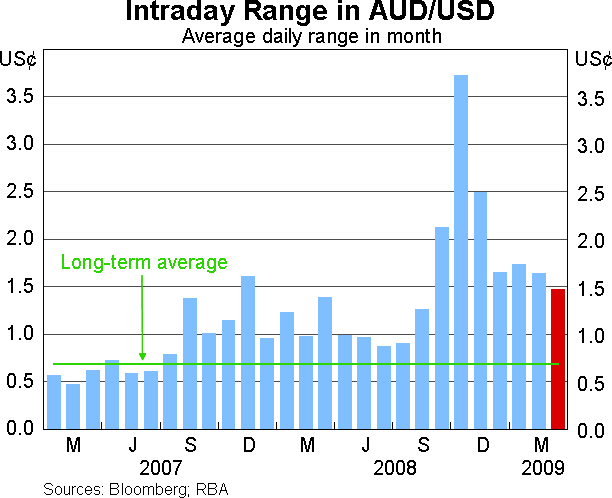
A number of the large movements in the Australian dollar have taken place in the last hours of trading in New York. During those times, there have been extraordinarily large movements in many financial prices in both directions. The Australian dollar has had a particularly high correlation at times with the S&P 500 (Graph 11), to some extent reflecting the fact that some investors regard the Australian dollar as a good proxy for global financial market sentiment.
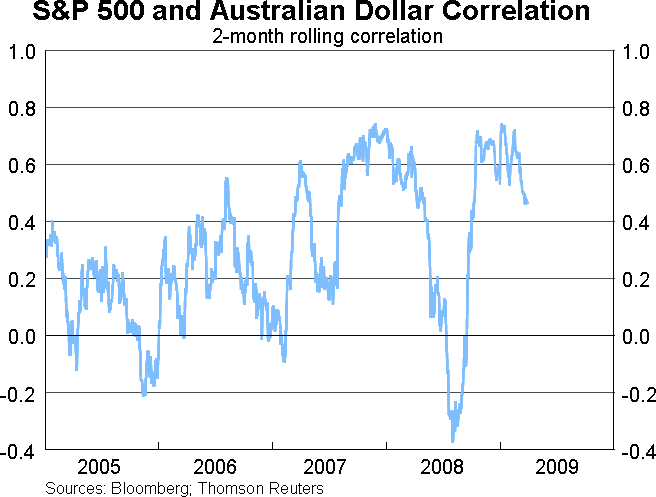
Reflecting very poor liquidity in the foreign exchange market on particular occasions throughout the crisis period, the Bank has stepped in to enhance liquidity in the market to ensure that price adjustments were as smooth as possible.
Finally, the foreign exchange swap market has also been dysfunctional at times. In particular, for much of the crisis period, there has been a global shortage of US dollars outside US markets. A recent article in the BIS Quarterly Review nicely describes the sources of this shortage.[3] As the article notes, much of the excess demand for US dollars in the swap market came from European banks to fund their US dollar-denominated assets. With the increase in counterparty risk aversion, American banks (who have easy access to US dollars) were less willing to lend to European banks. While originating in Europe, this shortage spilled over into other foreign exchange swap markets, including in this region.
To address this problem, the US Federal Reserve entered into swap agreements with a number of other central banks, including the RBA, to distribute more US dollars into these swap markets. The introduction of this facility, and in particular, the move to provide unlimited US dollars at a fixed price in Europe, the UK and Switzerland, seems to have contributed to a marked improvement in the market. In Australia, we have seen a marked drop in demand for this facility. At our two most recent auctions, we received bids of under US$2 billion against the $US 10 billion on offer at the auction, so that the total amount outstanding currently under this program is $US 9½ billion.
Conclusion
To conclude, the disruption in financial markets since the middle of 2007 has had a marked impact on Australian financial markets and the Australian economy. I have discussed some of those channels today, but there are a number of others that I have not covered here, which are covered in more detail in last week's FSR.
While local markets have been disrupted, the degree of dislocation has, in most cases, been considerably less than in other countries. One important reason for this is that the degree of counterparty risk aversion has been less in Australian markets given that Australian financial institutions had minimal exposure to the securities that have compromised the balance sheets of other financial institutions around the world.
Nevertheless, whilever the global financial system remains disrupted it will continue to undermine the effect of the sizeable policy stimulus being provided at the moment. The restoration of public confidence in the global financial system and the restoration of confidence between financial entities is a very necessary step on the road to global recovery.
Endnotes
I thank Josh Kirkwood for his assistance in preparing this talk. [1]
The Wizard of Oz was originally written as a financial allegory about the debate between the Gold Standard and William Jennings Bryan's desire for a Silver Standard. [2]
See P McGuire and G von Peter, ‘The US Dollar Shortage In Global Banking’, BIS Quarterly Review March 2009, pp 47–63. [3]
